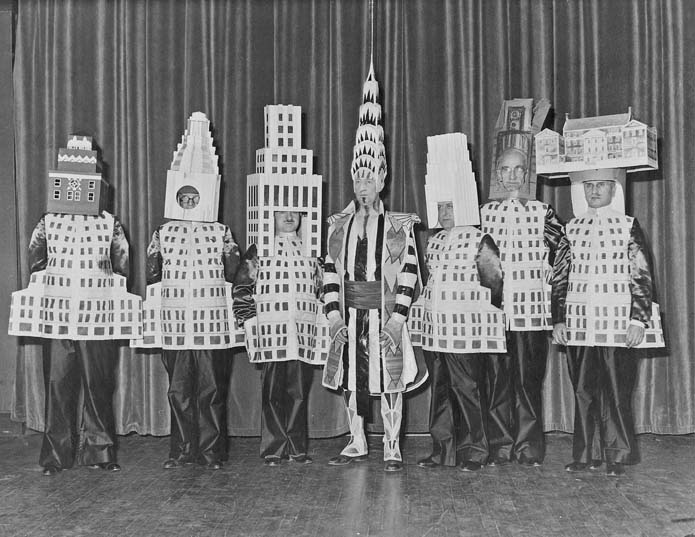In The Fountainhead, Rand offers a satirical description of an architectural costume party:
That winter the annual costume Arts Ball was an event of greater brilliance and originality than usual. Athelstan Beasely, the leading spirit of its organization, had had what he called a stroke of genius: all the architects were invited to come dressed as their best buildings. It was a huge success.
Peter Keating was the star of the evening. He looked wonderful as the Cosmo-Slotnick Building. An exact papier-mâché replica of his famous structure covered him from head to knees; one could not see his face, but his bright eyes peered from behind the windows of the top floor, and the crowning pyramid of the roof rose over his head; the colonnade hit him somewhere about the diaphragm, and he wagged a finger through the portals of the great entrance door. His legs were free to move with his usual elegance, in faultless dress trousers and patent-leather pumps.
Guy Francon was very impressive as the Frink National Bank Building, although the structure looked a little squatter than in the original, in order to allow for Francon’s stomach; the Hadrian torch over his head had a real electric bulb lit by a miniature battery. Ralston Holcombe was magnificent as a state capitol, and Gordon L. Prescott was very masculine as a grain elevator. Eugene Pettingill waddled about on his skinny, ancient legs, small and bent, an imposing Park Avenue hotel, with horn-rimmed spectacles peering from under the majestic tower. Two wits engaged in a duel, butting each other in the belly with famous spires, great landmarks of the city that greet the ships approaching from across the ocean. Everybody had lots of fun.
Many of the architects, Athelstan Beasely in particular, commented resentfully on Howard Roark who had been invited and did not come. They had expected to see him dressed as the Enright House. (Fountainhead, II.11)
Rand’s account was based on an actual historical incident that she recorded in her journals while working on the novel:
The Beaux-Arts Ball (January 23, 1931) where famous architects wore costumes representing one of their buildings. “Human Skyline for Beaux-Arts Ball.” … Note the little guy with the glasses peering through a hole in his headpiece – the Waldorf-Astoria. (Journals of Ayn Rand, p. 160)
Here, presumably, is the photo Rand saw:

(CHT Jesse Walker.)
I’ve gotta say, the Chrysler Building guy is cheating. Hat aside, his costume looks less like a building than like some sort of actual and rather snazzy clothing.
